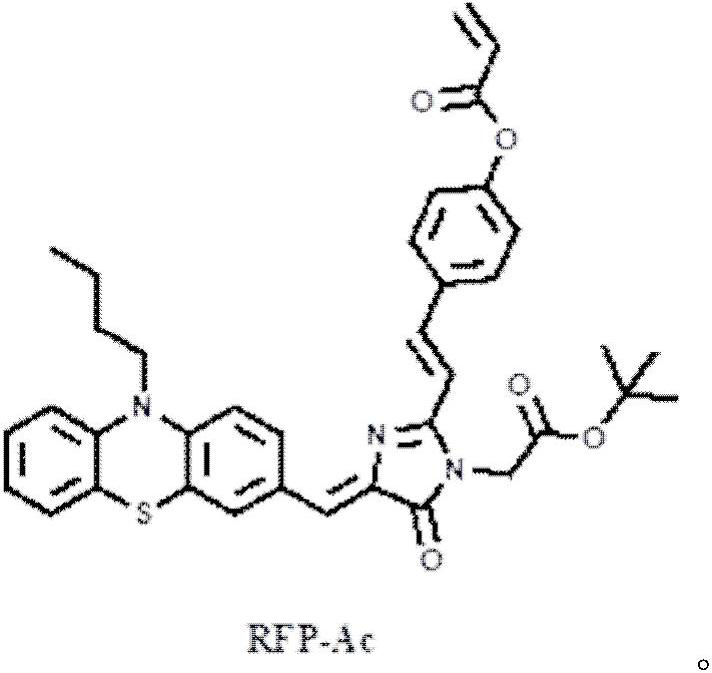A kind of red fluorescent protein two-photon photosensitizing dye and its preparation method and application
A red fluorescent protein and photosensitizing dye technology, which is applied in the field of red fluorescent protein-based two-photon photosensitizing dye RFP-Ac and its preparation, can solve the problems of large Stokes shift and low toxicity, and achieve large Stokes shift , low cytotoxicity and good biocompatibility
- Summary
- Abstract
- Description
- Claims
- Application Information
AI Technical Summary
Problems solved by technology
Method used
Image
Examples
Embodiment 1
[0023] (1) Preparation of red fluorescent protein two-photon photosensitizing dye RFP-Ac:
[0024] Under nitrogen protection and 110°C, 0.23g of phenothiazine fluorescent protein analog RFP-Me was weighed and dissolved in 30mL of dry toluene, 0.12g of p-hydroxybenzaldehyde was added, and then 5d of glacial acetic acid was added dropwise, and the reaction was stirred for 6h. After the reaction, it was separated and purified by column chromatography. 0.08 g of the resultant was weighed and dissolved in 20 mL of dry dichloromethane, 0.15 g of acryloyl chloride was added dropwise in an ice-water bath at 0°C, and then the reaction was raised to room temperature for 8 h. After the reaction, through extraction, washing, drying and column chromatography separation, the red fluorescent protein two-photon photosensitizing dye RFP-Ac was obtained, and the yield was 52%.
[0025] The synthetic route of the red fluorescent protein two-photon photosensitive dye RFP-Ac is as follows:
[00...
Embodiment 2
[0033] Example 2 Preparation of red fluorescent protein two-photon photosensitizing dye RFP-Ac
[0034] Under nitrogen protection and 110°C, 0.23g of phenothiazine fluorescent protein analog RFP-Me was weighed and dissolved in 30mL of dry toluene, 0.09g of p-hydroxybenzaldehyde was added, 5d of glacial acetic acid was added dropwise, and the reaction was stirred for 6h to complete the reaction. and isolate the resultant. 0.08 g of the resultant was weighed and dissolved in 20 mL of dry dichloromethane, 0.15 g of acryloyl chloride was added dropwise in an ice-water bath at 0°C, and then the reaction was raised to room temperature for 8 h. After the reaction, the red fluorescent protein two-photon photosensitizing dye RFP-Ac is obtained through extraction, washing, drying and column chromatography separation, and the yield is 50%.
Embodiment 3
[0035] Example 3 Preparation of red fluorescent protein two-photon photosensitizing dye RFP-Ac
[0036] Under nitrogen protection and 110 °C, 0.20 g of phenothiazine fluorescent protein analog RFP-Me was weighed and dissolved in 30 mL of dry toluene, 0.06 g of p-hydroxybenzaldehyde was added, and 5d of glacial acetic acid was added dropwise, and the reaction was stirred for 6 h to complete the reaction. and isolate the resultant. 0.08 g of the resultant was weighed and dissolved in 20 mL of dry dichloromethane, 0.15 g of acryloyl chloride was added dropwise in an ice-water bath at 0°C, and then the reaction was raised to room temperature for 8 h. After the reaction, through extraction, washing, drying and column chromatography separation, the red fluorescent protein two-photon photosensitizing dye RFP-Ac was obtained, and the yield was 47%.
PUM
 Login to View More
Login to View More Abstract
Description
Claims
Application Information
 Login to View More
Login to View More - Generate Ideas
- Intellectual Property
- Life Sciences
- Materials
- Tech Scout
- Unparalleled Data Quality
- Higher Quality Content
- 60% Fewer Hallucinations
Browse by: Latest US Patents, China's latest patents, Technical Efficacy Thesaurus, Application Domain, Technology Topic, Popular Technical Reports.
© 2025 PatSnap. All rights reserved.Legal|Privacy policy|Modern Slavery Act Transparency Statement|Sitemap|About US| Contact US: help@patsnap.com



